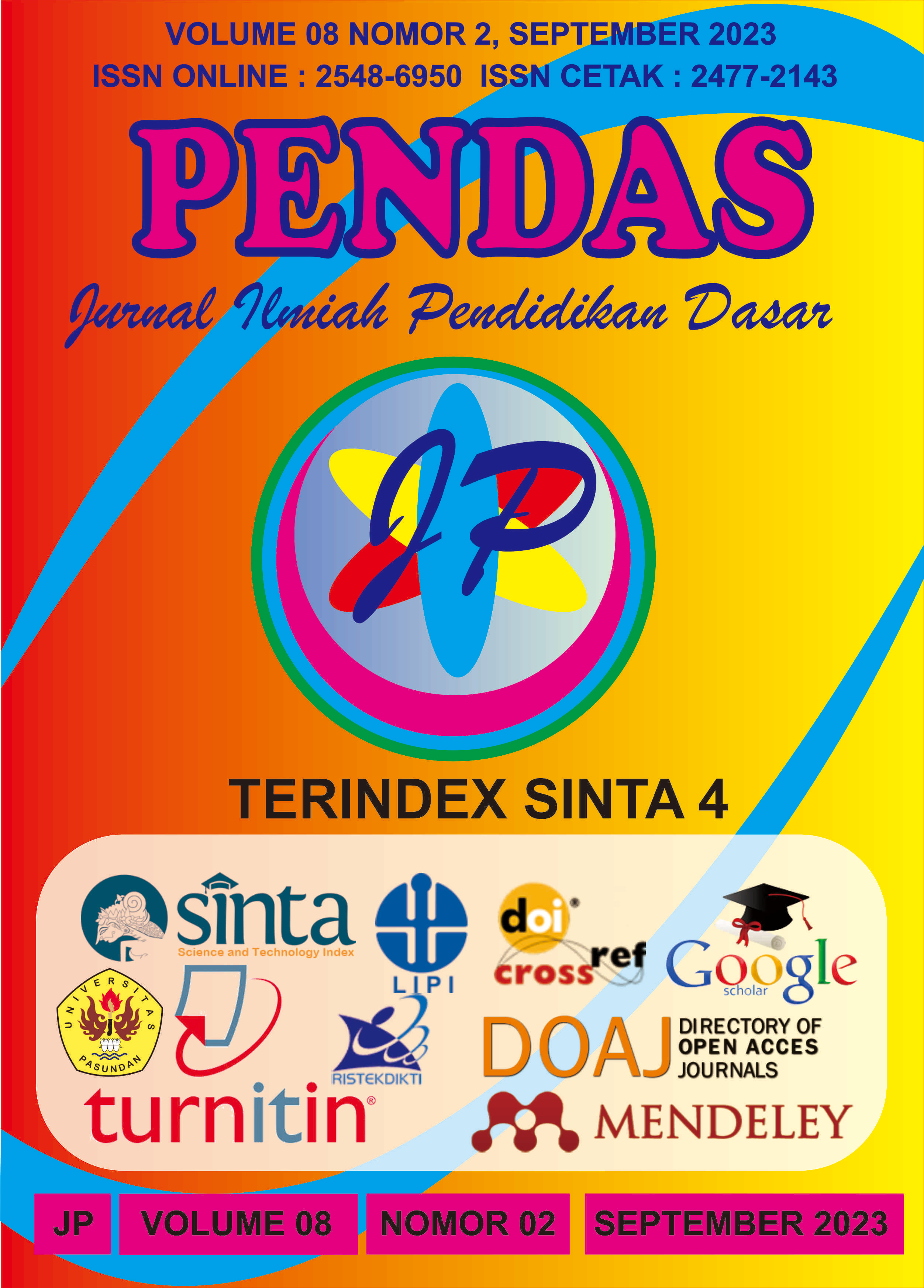ANALISIS KEMANDIRIAN BELAJAR SISWA PADA MATA PELAJARAN IPAS DI SD
DOI:
https://doi.org/10.23969/jp.v8i2.9212Keywords:
Keywords: Independence, Study, And IPASAbstract
This study aims to describe learning independence in social studies subjects in elementary schools. This type of research is qualitative research using descriptive methods. The subjects in this study were fourth grade students at SDN Kejapanan 3 with 20 students as subjects. The technique used to collect data in this study uses the angle of learning independence which consists of 12 stands with 6 indicators, namely not depending on others, self-confidence, discipline, own initiative, responsibility, and self-control. The data analysis technique used the formula for the percentage of student answers and then described using the search for disclosing the percentage of student answers. The research results obtained an average of 52.75% obtained from 20 students. With indicators Not dependent on others 49.5%, 46.5% Confidence, Discipline 60.5%, Have own initiative 57.5%, Responsibility 45.5%, and Self-control 57%. Based on this percentage, almost all students can learn independently, but the independence of learning to remember must always be improved so that students can develop their own independence in learning. Keywords: Independence, Study, And IPAS This study aims to describe learning independence in social studies subjects in elementary schools. This type of research is qualitative research using descriptive methods. The subjects in this study were fourth grade students at SDN Kejapanan 3 with 20 students as subjects. The technique used to collect data in this study uses the angle of learning independence which consists of 12 stands with 6 indicators, namely not depending on others, self-confidence, discipline, own initiative, responsibility, and self-control. The data analysis technique used the formula for the percentage of student answers and then described using the search for disclosing the percentage of student answers. The research results obtained an average of 52.75% obtained from 20 students. With indicators Not dependent on others 49.5%, 46.5% Confidence, Discipline 60.5%, Have own initiative 57.5%, Responsibility 45.5%, and Self-control 57%. Based on this percentage, almost all students can learn independently, but the independence of learning to remember must always be improved so that students can develop their own independence in learning.Downloads
References
Ansori, Y., & Herdiman, I. (2019). Pengaruh Kemandirian Belajar terhadap Kemampuan Pemecahan Masalah Matematis Siswa SMP. Journal of Medives : Journal of Mathematics Education IKIP Veteran Semarang, 3(1). https://doi.org/10.31331/medivesveteran.v3i1.646
Asriyanti, F. D., & Fitria, V. A. (2023). ANALISIS SIKAP DISIPLIN SISWA DALAM MENGIKUTI KEGIATAN EKSTRAKURIKULER SENI KARWITAN DI SD NEGERI BORO. Wahana Sekolah Dasar, 31(1), 8–14.
Ayu, I. G., Agustiana, T., & Tika, I. N. (2022). KURIKULUM MERDEKA BAGI GURU SD SE KECAMATAN JEMBRANA PASCA COVID -19. 461–466.
Desy Aprima, S. S. (2022). Analisis Penerapan Pembelajaran Berdiferensiasi Dalam Implementasi Kurikulum Merdeka Pada Pelajaran Matematika SD (pp. 95–101). 2022-09-17. https://doi.org/https://doi.org/10.35335/cendikia.v13i1.2960
Fadli, M. R. (2021). Memahami desain metode penelitian kualitatif. Humanika, 21(1), 33–54. https://doi.org/10.21831/hum.v21i1.38075
Febrita, Y., & Ulfah, M. (2019). Peranan Media Pembelajaran Untuk Meningkatkan Motivasi Belajar Siswa. Prosiding DPNPM Unindra 2019, 0812(2019), 181–188.
Fitriana, I., Martati, B., & Naila, I. (2021). Analisis Kemandirian Belajar Siswa Sekolah Dasar. Jurnal Pendidikan Tambusai, 5(1), 9946–9950.
Gusnita, Melisa, & Delyana, H. (2021). Kemandirian Belajar Melalui Model Pembelajaran Kooperatif Think Pair Square (TPSq). Jurnal BSIS, 3(2), 286–296. https://journal.upp.ac.id/index.php/absis/article/download/645/539
Khoirurijal. (2022). PENGEMBANGANN KURIKULUM MERDEKA. In 1 Agustus 2022 (Vol. 4, Issue 1).
Luthfiyah, F. (2020). Metode Penelitian Kualitatif (Sistematika Penelitian Kualitatif). In Bandung: Rosda Karya.
Rahayu, I. F., & Aini, I. N. (2021). Analisis Kemandirian Belajar dalam Pembelajaran Matematika pada Siswa SMP. Jurnal Pembelajaran Matematika Inovatif, 4(4), 789–798. https://doi.org/10.22460/jpmi.v4i4.789-798
Rahmawati, L. E., & Setyaningsih, V. I. (2021). Kemandirian belajar siswa dalam pembelajaran daring mata pelajaran bahasa Indonesia. KEMBARA: Jurnal Keilmuan Bahasa, Sastra, Dan Pengajarannya, 7(2 SE - Articles).
Safitri, A., & Lestari, K. E. (2022). Analisis Kelancaran Prosedural Matematis Siswa Berdasarkan Kemandirian Belajar. Jurnal Educatio FKIP UNMA, 8(2), 444–452. https://doi.org/10.31949/educatio.v8i2.1979
Salima, H. (2019). Analisis Kemandirian Belajar Siswa Dalam Pembelajaran Tematik di Kelas 2 SDI Al-AZHAR 17 Bintaro. Skripsi, 1–184.
Suari Ni putu. (2018). View of Penerapan Model Pembelajaran Problem Based Learning untuk Meningkatkan Motivasi Belajar IPA. In Jurnal Ilmiah Sekolah Dasar (Vol. 2, p. 3). https://ejournal.undiksha.ac.id/index.php/JISD/article/view/16138/9597
Sugiyono. (2018). Metode Penelitian Kuantitatif, Kualitatif, dan R&D. Prof. Dr. Sugiyono. 2018. Metode Penelitian Kuantitatif, Kualitatif, Dan R&D. Bandung: Alfabeta.
Sugiyono. (2022). METODE PENELITIAN KUALITATIF. bandung: ALFABETA.
Sundari, S., Fuadi, D., & Hidayati, Y. M. (2022). Kemandirian Belajar Matematika Masa Pandemi Covid-19 pada Siswa Sekolah Dasar. Jurnal Basicedu, 6(1), 1389–1397. https://doi.org/10.31004/basicedu.v6i1.2233
Suryati, A., Nurmila, N., & Rahman, C. (2019). Konsep Ilmu Dalam Al-Qur’an: Studi Tafsir Surat Al-Mujadilah Ayat 11 Dan Surat Shaad Ayat 29. Al Tadabbur Jurnal Ilmu Alquran Dan Tafsir, 04(02), 217–227. https://doi.org/10.30868/at.v4i02.476
Syifa, U. Z., Ardianti, S. D., & Masfuah, S. (2022). Analisis Nilai Karakter Tanggung Jawab Anak Dalam Pembelajaran Daring. Jurnal Educatio FKIP UNMA, 8(2), 568–577. https://doi.org/10.31949/educatio.v8i2.2071
Tresnaningsih, F., Santi, D. P. D., & Suminarsih, E. (2019). Kemandirian Belajar Siswa Kelas Iii Sdn Karang Jalak I Dalam Pembelajaran Tematik. Pedagogi: Jurnal Penelitian Pendidikan, 6(2), 51–59. https://doi.org/10.25134/pedagogi.v6i2.2407
Umi, I. (2022). ANALISIS KEBUTUHAN AWAL PENGEMBANGAN BAHAN AJAR PEMBELAJARAN BERDIFERENSIASI BERBASIS KEARIFAN LOKAL KABUPATEN PEKALONGAN MATA PELAJARAN IPAS KELAS IV SEKOLAH DASAR. 2022. https://doi.org/https://doi.org/10.51903/semnastekmu.v2i1.188
Zahir, A., Nasser, R., Supriadi, S., & Jusrianto, J. (2022). Implementasi kurikulum merdeka jenjang SD kabupaten luwu timur. Jurnal Ilmu Pengetahuan Dan Teknologi Bagi Masyarakat, 2(2), 1–8.
Zahwa, N. R., & Erwin, E. (2022). Pengaruh Model Pembelajaran Index Card Match terhadap Motivasi Belajar IPA Siswa Sekolah Dasar. In Jurnal Basicedu (Vol. 6, Issue 4, pp. 7503–7509). https://doi.org/10.31004/basicedu.v6i4.3538
Downloads
Published
Issue
Section
License
Copyright (c) 2023 Pendas : Jurnal Ilmiah Pendidikan Dasar

This work is licensed under a Creative Commons Attribution 4.0 International License.



















